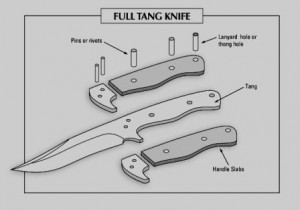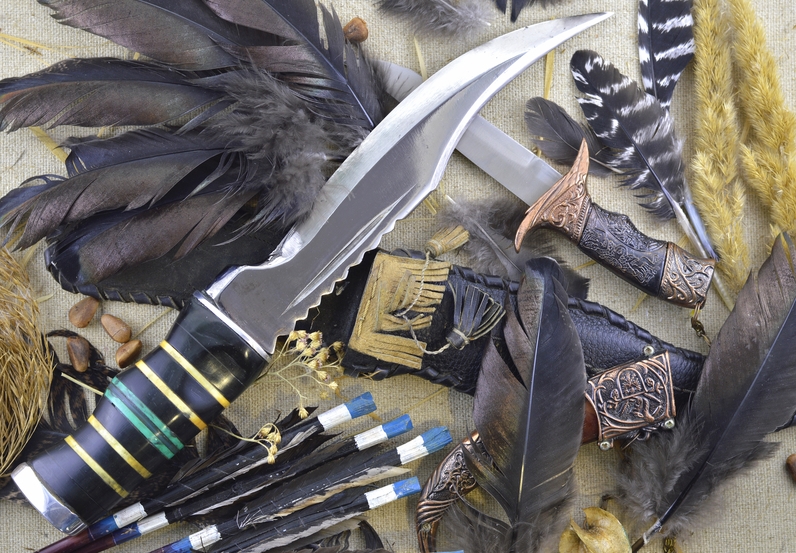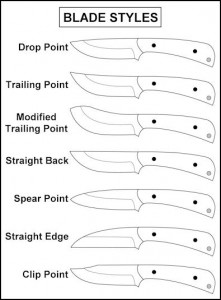Choosing the best knife for hunting is not an easy task, because there’s a plethora of models available, especially over the internet. Sometimes you can get confused, they all seem to look the same after all, so why bother choosing? Just flip a coin and pick one. Well, keep reading and I will show you how to distinguish a good hunting knife from a “lemon”.
First things first, you should establish what kind of knife you want and obviously, a budget. Keep in mind that a decent hunting knife can cost you anywhere between $50 and $1000 or more. Yes, there are knives that cost that much, folks. But a hunting knife being essentially a tool, it makes no sense to break the bank.
A good hunting knife must perform flawlessly its main task: skinning the animal and dressing game, i.e. splitting the ribcage and cutting through bone and cartilage. So, the general rule of thumb is that a hunting knife must be pretty strong, for achieving its main goals.
Let me give you a tip: when talking about hunting knives, bigger doesn’t necessarily mean better. It all depends on the size of the animal you wish to hunt. A big knife is useless when dressing small game, as you can easily imagine. If you’re hunting rabbit, you can’t use the same type of knife like someone who’s into big game hunting, like deer for example. Regardless, as a general rule, a good hunting knife has a blade length of ~4 inches, give or take, unless you’re hunting elephants or the like.
After you’ve decided about what size of knife you will require, you must consider how often you will go hunting. If you’re a regular hunter, that spells fixed blade knife. If you’re hunting occasionally, well, a folder is the way to go.
Types of Hunting Knives
So, there are basically two types of hunting knives:
-fixed blade knives
-folders
As a general rule of thumb, fixed blade knives are the best ones from all points of view except for one (they are not that easy to carry around due to their size):
-they are stronger
-they are cheaper
-they are more reliable
All these benefits derive from the fact that a fixed blade knife has no moving parts, like a folder knife has. Folders are more versatile and easier to carry around.
If you go for a folder knife, don’t get cheap, because cheap folders are not built to last. You should choose a reputable company and pay extra attention (and money eventually) at the locking mechanism of the blade. Yes, you must go for a strong lock-back folder knife, with a thick blade and a grippy handle. Also, a partially serrated blade works best in a folding knife, making it very versatile, especially when cutting through cartilage and tendons.
If you’re a dedicated hunter, a solid fixed blade knife is the name of the game for you, there’s no compromise here. For regular, heavy duty jobs, a folding knife is usually not enough.
So, what are the basics in choosing a good fixed blade knife?
Well, there are three types of blades used in hunting knives: the clip point, the drop point and the skinning blade. One must choose according to his/her needs; from these three, the clip point is the more versatile solution, the other two are “niche” knives.
What makes a good hunting knife?
1. The blade must feature a full tang design, meaning that the handle and the blade are made of one continuous piece of steel. This makes for a strong, unbreakable knife, if used properly. Stay away from partial tang designs, they are prone to failure and they are definitely not worth it.

A carbon steel knife is cheaper, rugged and durable, easy to sharpen and strong, yet it is prone to rusting. A stainless steel hunting knife doesn’t require so much attention and it’s the ideal choice, especially if you go for a high quality blade.
Stainless steel blades are the popular choice amongst hunters everywhere, even if they’re a little bit harder to sharpen and they don’t keep an edge as well as a carbon steel does, but they are close enough in my book.
3. If you choose to go for carbon steel, you can easily prevent the blade from rusting by applying a silicon containing wax over it or you can go old school and keep it oiled at all times. This kind of steel requires maintenance and a hunting knife will see some dirty action during its lifetime. My advice is to play safe and go for a stainless steel blade, or, if you’re loaded, you can choose the high end option, i.e. the high carbon stainless steel version, used by expensive knife makers.
4. The handle of the knife must be very comfortable for your hand, to provide good grip under wet conditions and also be made of a strong material, that doesn’t deteriorate in humid conditions. Hence, stay away from leather handles, even if they look cool; also, avoid bone and wooden handles, because they are fragile and/or slippery when wet. The best choice for a hunting knife handle is a synthetic material, like polymer, nylon, rubbery plastic, stuff like that. The handle must be sturdy and feel strong and heavy in your hand.
Keep in mind that a high-quality hunting knife, well maintained, will last you for a life time. All you have to do to keep it in shape is to clean the blade and handle thoroughly after using it and store it in a clean, dry place. You can use a commercial cleaning solution that contains a lubricant/protector in its composition, even if you’re using a stainless steel blade. Stainless steel blades are not immune to rusting after all, just more resistant.
These are the basics in choosing the best knife for hunting. The rest is up to you, it all depends on your personal preference and budget. As per any other thing in life, you get what you paid for.
Keep your knife sharp and your eyes peeled!
This article has been written by Chris Black for Survivopedia.










kukriking | January 30, 2014
|
The very best high carbon stainless, S30V, is still too expensive, whereas ATS34 & 154CM has become more reasonably priced and in my experience, served me just as well as my VERY expensive S30V knives. I’m a collector, so I have a huge variety. A rubber handle is the best for grip and easey CLEANING. Porous materials will retain flesh and blood. Another VERY grippy and more durable handle is G-10 and Micarta- not quite as easy to clean as rubber, but they are nearly indestructible.
The best all around camp/survival/SHTF fixed blade knife is the KUKRI. Cold Sreel makes a high carbon stainless kukri FOLDER; the Rajah II (bigger) & Rajah III, perfect for hunting. The Rajah III has the best all around skinning size. Handles are tough and easy to clean Grivory
Larry Pearson | January 30, 2014
|
My dad never used anything but a 3 blade kaybar on everything from quail to beef to deer in his life. That included splitting the breast bone. Never got the hang of it myself so always used a fixed blade on beef and deer although I do use a pocket knife on quail and small game. A pocket knife it the only tool to use when cutting calves, colts or pigs. Never leave home without one.
Larry Crooks | January 31, 2014
|
I like the s30 V steel but are expensive. Partial to Buck but also have lots of good different brand knives. Larry
ERIC | February 3, 2014
|
Hum, well, I guess that is the difference between a Hunting Knife and a Survival Knife. If I am going to carry a knife, I choose to carry a tool that can be used in any situation. I’ll take a good old fashioned hand forged blade any day over a stainless blade. Stainless is fine, if you don’t need to worry about it breaking/snapping or cracking. I would rather spend a little, or a lot, more up front for the piece of mind of knowing that I have a tool that will last, take the abuse that I will put it through and is something that I can trust to save my life if necessary. You can’t say that about any stainless steel blades. Stainless blades belong in the kitchen or hospital. You see, all steel has a grain to it as a result of it’s milling process when being made. This grain is an inherent weakness when it comes to blades. If the grain runs vertical through the blade, it’ll snap. If it runs horizontal along the blade it will be nearly impossible to sharpen, or worse it’ll split along that grain when too much pressure is applied. This is overcome in forged blades when the craftsman hammers the heated steel. He is in essence destroying the factory grain and creating a random pattern in the carbon steel, and through through the processes of quenching and tempering, or hardening and then softening the blades. The problem with stainless is the chromium content which makes the blade rust resistant which is why we buy them for kitchens. If during the knife making process you get it too hot, you “burn” the chromium and the knife is no longer rust resistant and therefore stainless can’t be fire forged. The best that they can do is cook them in an oven making the entire blade hard. This is important as you will see. Also because of the Chromium content, the blade cannot be selectively tempered because the Chromium transfers the tell-tail colors too far and at too varying a time rate to be accurate thus making it impossible to selectively temper a stainless steel knife. A knife’s strength comes from two factors. 1. it’s hard edge, or the cutting edge. Too hard and again it’ll be hard to sharpen, too soft and it won’t hold an edge. 2. the softer, or back of the knife. You want these two different for strength and flexibility. According to the American Bladesmithing Assoc., a blade should be able to be bent to beyond 90 degrees without breaking or cracking. Try that with your stainless. Authentic Japanese Samurai swords are made this way and their durability is legendary. A Samurai’s sword was not only a weapon, but a tool as well. I don’t see any of those being made of stainless steel, except for the ones sold to tourists. A Samurai’s sword was made of layers of carbon steel. Be like the Samurai, and get yourself a multi-purpose tool; instead of a nice shiny waste of money. I’ve never needed to cut a deer out of a 55 gallon steel barrel or cut a hole through armor plate with a sledge hammer and a knife(no exaggeration), but it’s nice to know that if I needed to, I have the tool that will do it. When you are hanging 60′ feet off of a cliff though, and the only thing holding you there is your knife and a tight grip, it’s not the time to start wondering if the blade will hold.
ERIC | February 3, 2014
|
I forgot to mention, “According to the American Bladesmithing Assoc., a blade should be able to be bent to beyond 90 degrees without breaking or cracking. ” Once the Blade is released, it must flex back to within 5 degrees of it’s original state. Try that with your stainless blade!
ERIC | February 3, 2014
|
I forgot to mention, Once the Blade is released, it must flex back to within 5 degrees of it’s original state. Now try that with your stainless blade!
headhunter | March 7, 2014
|
You’re right in respect to blade length. I’m can’t see any use in a serrated knife unless you’re working with plastic rope, they are just a pain to sharpen. I’m 66 years old and have yet to figure out why the average guy would want to bend a knife at an angle of 90 degrees. I have both stainless and carbon steel knives. The carbon steel, if I’m putting them away for a long period, get a coat of auto wax. Yes, I own Cold Steel, Benchmade, Uncle Henry (made in the USA), Gerber, and Buck.
Try taking a stick 12 inches long and push it down on a flat surface. Now try the same stick when it is only seven inches long (try a pencil). Which one were you able to push on the flat surface with the most force? A shorter bladed knife allows you to apply more force and more importantly you control that force.
A knife for gutting is not the best knife for skinning nor is it the best knife for butchering. A short sharp knife with a drop point will get you started gutting. A gut hook will speed the process greatly. A knife with a “belly” (an edge with a convex shape) works well in skinning, especially if you want to save the hide and you can use the gut hook again to simplify opening the hide up without getting hair all over.
Buck knives (made in the USA) makes two knives ideal for deer (and elk, and moose) . The first is the Duke (a folder that comes with sharp edges on the handle that are easily removed) and the Alpha ( a folder with a rubber grip). The first is over 20 years experienced and there is no blade looseness after deer, antelope, and bull elk. Outdoor edge with its swing blade for a gut hook is my next “want”, but I have a really cheap Camillus gut hook that is too good to get rid of. Buck and in the past Gerber have make skinning knives. A folding fish knife is hard to beat for butchering. It will dull quickly , but sharpens just as quickly.
Gloves are good. If you have the elephant sized gloves that extend all the way up your arm- put on a pair of surgical gloves over the top so you still control what you are doing.
Talking of buck deer- cutting the penis off involves grabbing the penis with your off hand and with your dominant hand slicing down and as you get to the scrotum, follow the urethra to the rectum- do not puncture either. Don’t contaminate your knife by messing with the anal opening at this point. The cutting opens the hide, but the entrails are still going to be held in.
Then its time to open the abdominal cavity, have your deer positioned so the “guts” will roll out the down hill side- unless you want to stand in them. (Not a good idea.) Putting the deer’s head up hill means the guts will be pulled over almost all of the meat- not so cool.
Use a blunt tipped knife or gut hook. First, between the hind legs make a small cut in the belly,then facing the head simply slide the blunt tip knife into your opening and slide it toward the head.
.If you are using a standard knife, a drop point is best. First , between the hind legs make a small cut in the belly, then facing the head insert two fingers of your off hand into the cut and pull gently outward. Using your dominant hand insert the knife between the other hand’s fingers with the edge outward. Keeping the edge between your fingers begin your slice toward the sternum.
Don’t cut bone! Finesse your way!
A father was heard to tell his son ,” You want a long blade so you don’t get your hands bloody.” That is not how you need to do it!
When you slice upward through the chest cavity move your knife slightly off center (about an inch) and YOU CAN SLICE CARTILAGE ALL THE WAY UP instead of fighting with bone. The diaphragm separates the chest and belly, this will have to be cut out of the way-gently and carefully. Cut up the neck as far as possible. It’s time to sever the trachea and the esophagus as close to the head as possible.
The intestines ate still attached on the bottom end. Cutting through the pelvis used to made this a simple job, but , since the advance of chronic wasting disease it’s recommended we don’t risk contaminating meat with spinal fluid or bone marrow. So we need to free the bottom of the deers alimentary canal. Cut carefully around the anal opening and mostly by using your gloved hands free the canal. When it’s free tie the very bottom in a simple over hand knot and remove all (The knot keeps the manure off your meat . Be sure to close off the bladder too.) When your done gutting, get the meat to cooling , if you are in country with low bushes simply drape your animal over a bush. If not prop the abdominal cavity and chest cavity open with branches.
In general, cuts made lifting the knife get less hair in the meat. The tools like the “Switch Blades” from Outdoor Knives are wonderful. You slide the blunt tip between the meat and hair and slide the blade where you wish to go. Some cuts like those up the legs toward the body,that once were a pain, are almost effortless. When you’re cutting meat, cut it across the grain, it makes it easier once it’s on the dinner plate.
If you’ve killed the buck of a lifetime and intend on having it mounted, when you’re gutting cut reaches the sternum STOP. Now you will need to cut through the diaphragm. When you have dispensed with the heart and lungs reach up as far as humanly possible to sever the esophagus and trachea. The esophagus will be full of bacteria from the deer’s eating so it will spoil quite quickly if not entirely removed.
If you are transporting a deer a long way and it is hot, either bone it out or make sure the sun can’t hit it (no translucent plastic) and pack the body cavity with ice- to the extent of placing a block between the legs and tying them together.
Being redundant, you don’t want to cut bone, you don’t want to cut yourselb – control id important. If you must quarter an animal, use a saw.
Pingback:How To Choose A Good Knife For Hunting – My Blog | May 16, 2016
|
Paul Esterline | September 29, 2017
|
Stainless steel is NOT your best choice by far! You say that carbon steel is cheap and not as good as stainless. You truly have this backwards. I am a full time custom knife maker, if you want me to make you an inexpensive knife for “show but not for go” I will use stainless, it is WAY cheaper then any carbon steel. True it is free of maintenance, and real stainless doesn’t rust… ever. The real junk is just plated and will rust. Simi-stainless such as D2 will rust almost as easily as carbon steel, and is more expensive. A knife is a tool, the job of that tool is to cut. If carbon steel cuts better and gets and stays sharper longer, why would you ever sacrifice that just so you don’t have to wipe your blade dry after you use it? I wont! If i am working in the cold, or dark, or any other very real situations that one encounters hunting, the last thing i want is to have to stop in the middle of my job, risking meat, my safety, my health, to sharpen my knife because I followed this advice and bought Stainless! I agree with some of what you say.. Full tang YES! Synthetic handle sometimes, some wood, bone and antler, are very good as well, and is just as easy to care for. Some synthetic is just cheap plastic and I refuse to even use it. All handle material can be slippery when wet, leather is actually rather “grippy” went wet. My knives are not cheap, but they are also not outrageous. I guarantee my blades for life (i am sure other makers do as well). Yes you get what you pay for, but don’t buy stainless and expect a good knife.
Bill Bernhardt | October 27, 2018
|
I found another good article on this topic at https://www.foundryoutdoors.com/blogs/blog/how-to-choose-a-hunting-knife.